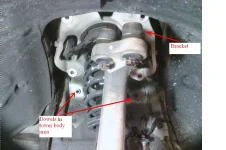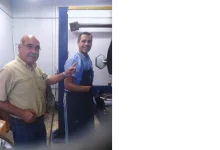inmanlanier
Getting familiar with the group...
- Joined
- Jun 9, 2011
- Messages
- 200
- Reaction score
- 54
- Points
- 28
- Location
- Palm Beach Gardens, FL
- Genesis Model Type
- 2G Genesis Sedan (2015-2016)
My 4.6L Genesis sedan has pulled to the right since I owned it at 4700. I’d call it a light to moderate pull, enough to bother me most of the time. Rotating the OEM tires 3 times and new tires at 27K miles (conti DSWs) did nothing to change. On a light to moderate left crown road – it still pulled slightly right. I’ve read a lot of posts (many with misinformation regarding which aspects of alignment influence pull). I’ve confirmed that the front suspension only has factory adjustable toe, and the rear factory adjustable toe and camber.
On the rack, without an occupant, the car was showed alignment as per the following (L/R – degrees): Front Camber -1.1/-.8; Caster 7.9/8.0; toed in .35 degrees. With my weight in the driver’s seat, Camber -1.2/-1 Caster 7.9/8.0.
Caster is the predominant influence on pull, with Camber also influencing to some degree. In my case, the data inferred that the camber was the greatest influence on pull. The left front camber was well more than needed and the rear camber was -2.1/-2 – also excessive IMHO. I had seen significant inner tire wear on my old tires so I wanted to eliminate that tendency.
I went to Bello’s Motorsport here in West Palm Beach. Ernie (owner), and his technician Marcello [see photo below Ernie on left!] and I noodled on the geometry and design. There’s a good pictorial of the layout at this link: http://blogs.insideline.com/roadtes...i-genesis-v6-sedan-suspension-walkaround.html . The V-8 appears to be the same but the calipers are 4 piston, non-floating. My strategy was to try and move/adjust the upper suspension member mounting plate where it attaches to the strut tower area. They concurred. After discussing, we decided to shim behind the plate where the 2 rear bolts (top and bottom) of the mounting plate attach to the tower body area. This would kick it out some (to reduce negative camber), and kick it forward slightly (reducing the positive caster). The thought was that getting more caster bias from right to left would reduce the pull, and also reducing the camber bias would help as well (let alone reduce my inner tire wear).
We disconnected the left side lower control arm from the coilover, then removed all 4 bolts holding the upper bracket to the tower. We pulled the upper arms/bracket assembly out and away from the tower. Unfortunately the lower bolt holes have dowels in the tower, so simply slotting the bracket holes would not be easy. (I hope the photo I "attached" made it).
We then went and got some large washers that would go over the lower rear dowel and pull the rear of the plate away from the tower. We used 2 washers on the top and 2 washers on the bottom, behind the bracket.
Tow hiccups – since the bolt hole axes are in different planes, when re-inserting the bolts one of them began to cross-thread. We stopped and chased the hole with a tap. No damage done. After shimming and reinstalling the plate, we only had 5 threads engaged in the rear bolts – marginal (likely would have been fine, but why risk it). These are 10mm X 1.25 pitch, high strength Asian marking of 10. The general rule of thumb is full diameter thread engagement (approx. 7 ½ threads). Longer ones were found to replace. The original length was about 38 mm of thread (with a pointed tip for ease of insertion). We got high strength replacements with thread of approximately 45 mm length.
After reinstalling and putting it back together – as-left measurements with weight in the driver seat were: Camber -.5/-.7; Caster 7.4/8.0, and .17 degrees toe – in – good numbers! This increased the caster bias from 0.1 degrees to 0.6 degrees – an increase in ½ degree to help counter the road crown effect of pulling to the right. Furthermore, the left side camber was no longer too much with a final bias of 0.2 degrees – should be no effect on pull. The rear camber was set at -.5 / -.7 with .34 toe in.
After putting the tires back on, there was still some slight pull to the right – so on a hunch, we swapped the front tires (they were now scuffed in after about ~2000 miles). We had not done that with the new ones since they pulled like the old ones before. Now with me alone the car tracks pretty strait with a slight pull to the right on the more heavily crowned roads. If the road is flat, there’s a very slight pull left. For me, this is the right balance since most roads I drive have a moderate crown to the right.
Hope this helps y’all.
On the rack, without an occupant, the car was showed alignment as per the following (L/R – degrees): Front Camber -1.1/-.8; Caster 7.9/8.0; toed in .35 degrees. With my weight in the driver’s seat, Camber -1.2/-1 Caster 7.9/8.0.
Caster is the predominant influence on pull, with Camber also influencing to some degree. In my case, the data inferred that the camber was the greatest influence on pull. The left front camber was well more than needed and the rear camber was -2.1/-2 – also excessive IMHO. I had seen significant inner tire wear on my old tires so I wanted to eliminate that tendency.
I went to Bello’s Motorsport here in West Palm Beach. Ernie (owner), and his technician Marcello [see photo below Ernie on left!] and I noodled on the geometry and design. There’s a good pictorial of the layout at this link: http://blogs.insideline.com/roadtes...i-genesis-v6-sedan-suspension-walkaround.html . The V-8 appears to be the same but the calipers are 4 piston, non-floating. My strategy was to try and move/adjust the upper suspension member mounting plate where it attaches to the strut tower area. They concurred. After discussing, we decided to shim behind the plate where the 2 rear bolts (top and bottom) of the mounting plate attach to the tower body area. This would kick it out some (to reduce negative camber), and kick it forward slightly (reducing the positive caster). The thought was that getting more caster bias from right to left would reduce the pull, and also reducing the camber bias would help as well (let alone reduce my inner tire wear).
We disconnected the left side lower control arm from the coilover, then removed all 4 bolts holding the upper bracket to the tower. We pulled the upper arms/bracket assembly out and away from the tower. Unfortunately the lower bolt holes have dowels in the tower, so simply slotting the bracket holes would not be easy. (I hope the photo I "attached" made it).
We then went and got some large washers that would go over the lower rear dowel and pull the rear of the plate away from the tower. We used 2 washers on the top and 2 washers on the bottom, behind the bracket.
Tow hiccups – since the bolt hole axes are in different planes, when re-inserting the bolts one of them began to cross-thread. We stopped and chased the hole with a tap. No damage done. After shimming and reinstalling the plate, we only had 5 threads engaged in the rear bolts – marginal (likely would have been fine, but why risk it). These are 10mm X 1.25 pitch, high strength Asian marking of 10. The general rule of thumb is full diameter thread engagement (approx. 7 ½ threads). Longer ones were found to replace. The original length was about 38 mm of thread (with a pointed tip for ease of insertion). We got high strength replacements with thread of approximately 45 mm length.
After reinstalling and putting it back together – as-left measurements with weight in the driver seat were: Camber -.5/-.7; Caster 7.4/8.0, and .17 degrees toe – in – good numbers! This increased the caster bias from 0.1 degrees to 0.6 degrees – an increase in ½ degree to help counter the road crown effect of pulling to the right. Furthermore, the left side camber was no longer too much with a final bias of 0.2 degrees – should be no effect on pull. The rear camber was set at -.5 / -.7 with .34 toe in.
After putting the tires back on, there was still some slight pull to the right – so on a hunch, we swapped the front tires (they were now scuffed in after about ~2000 miles). We had not done that with the new ones since they pulled like the old ones before. Now with me alone the car tracks pretty strait with a slight pull to the right on the more heavily crowned roads. If the road is flat, there’s a very slight pull left. For me, this is the right balance since most roads I drive have a moderate crown to the right.
Hope this helps y’all.
Attachments
Last edited:







